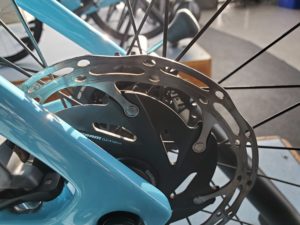Among the many trends in triathlon tech that have gained momentum in the last few years is the increase in disc brakes on tri and road bikes. What’s the deal and do you need them? If you come from a mountain bike background, disc brakes are nothing new—they’ve been used for years—where fast stopping power on gnarly trails and hectic descents is a must. But the popularity of their use on road and tri bikes (which typically feature rim brakes), is still pretty new. What’s that deal?
How do they work?
Simply speaking, they get their name because of the small metal disc (referred to as a rotor) attached to the hub.  A caliper affixed to either the frame or the fork squeezes the rotor when the rider puts pressure on the brake lever. Most sets are cable or hydraulic. The resulting friction on the rotor gives riders increased control over braking particularly in wet conditions. Once installed, they don’t go out of alignment. If you’ve ever tried to finish a race with a brake rubbing against your wheel, you’ll understand the value of this! Because tire clearance is not an issue with the disc set up, you can run wider tires as needed. Typically, tri and road bikes use a quick release skewer to hold wheels in place. Disc brakes, on the other hand, require a thru-axle which does take a bit more time (and sometimes an allen key) when swapping out wheels, changing flats, or even mounting your bike on a trainer.
A caliper affixed to either the frame or the fork squeezes the rotor when the rider puts pressure on the brake lever. Most sets are cable or hydraulic. The resulting friction on the rotor gives riders increased control over braking particularly in wet conditions. Once installed, they don’t go out of alignment. If you’ve ever tried to finish a race with a brake rubbing against your wheel, you’ll understand the value of this! Because tire clearance is not an issue with the disc set up, you can run wider tires as needed. Typically, tri and road bikes use a quick release skewer to hold wheels in place. Disc brakes, on the other hand, require a thru-axle which does take a bit more time (and sometimes an allen key) when swapping out wheels, changing flats, or even mounting your bike on a trainer.
If you’ve noticed the gorgeous baby-blue Trek Madone bikes that Coach Tara and I have been riding, you’ll see they are equipped  with disc brakes. This is the first bike I’ve ridden extensively that has disc brakes. Prior to this I did some product testing for Liv/Giant a few years ago in the rainy, hilly conditions of spring in Scotland. Riding fast with a group of journalists and gear junkies down the blind corners of Scottish hillsides in the rain was an excellent way to see what they could do! I was an instant convert.
with disc brakes. This is the first bike I’ve ridden extensively that has disc brakes. Prior to this I did some product testing for Liv/Giant a few years ago in the rainy, hilly conditions of spring in Scotland. Riding fast with a group of journalists and gear junkies down the blind corners of Scottish hillsides in the rain was an excellent way to see what they could do! I was an instant convert.
More recently, during our R2//NYC, Tara and I were both happy to have disc brakes as we bombed down some steep descents in the Adirondacks. Hitting a downhill after the seemingly endless climbing of our 170km a day average was such a welcome reprieve. Taking full advantage of the speed where we could get it was possible in part because of the confidence in our stopping power.
Cyclist and go-to chiropractor for many Team Atomica athletes, Dr. Lise Rok, explains her own experience riding disc brakes:
“I encourage athletes to use hydraulic disc brakes because they outperform rim brakes in poor weather conditions which reduces the risk of crashes on training rides, during commutes, or prolonged descents.” As a healthcare professional Dr. Rok is cognizant of doing all one can to stay safe. She explains: “Let’s say an athlete falls off their bike. Most likely, they’ll get a head injury or break a bone in their face, shoulder, or arm1. Fractures take up to 6-8 weeks to heal2. Recovery time is even longer if surgery is needed. Once healthy, the athlete needs to rebuild their cardiovascular fitness. It’s a significant amount of time that can quickly impact an athlete’s racing season.”
Elite short course triathlete Leanna Lee agrees that disc brakes “are much more responsive than standard brakes, and they do seem to provide for smoother and more evenly distributed breaking power.” She insists, this gives her a feeling of additional safety especially during group rides, making long, technical descents, or in wet weather conditions. However, Lee explains some of the less-discussed aspects she’s encountered riding them, indicating that they’re “more sensitive to getting dirt and water between them” making for loud, screeching stops. She advises putting in “a little extra effort is required to keep them clean for proper functioning in between rides.” Lee also explained the need to be cautious when travelling:
“Having properly fitting spacers that sit snuggly between your brakes is essential. Otherwise, when you open your bike case, you might find that your spacers have popped out during the turbulent plane ride, and that your brake pads have slammed shut and you cannot get your wheels on. This may lead to undue stress and finding yourself using Google Translate to translate the word ‘butter knife’ to your hotel concierge, in a last-ditch effort to pry open your brake pads a day or two before your race.”
Being mindful of these precautions, however, seems fairly easy and worth the benefit of safer stopping power.
TT bikes are heavier than road bikes and, of course, are built to go in one direction with as little braking as possible. Why would triathletes want disc brakes then? Well, for all the same reasons outlined above and although we won’t likely hit the brakes in a race, we do put in many kilometres in training under all kinds of conditions. As a coach, I’m in favour of anything that contributes to an athlete’s confidence. Feeling in control and confident will absolutely lead to a better (and faster) rider.
- Mellion MB. Common cycling injuries. Management and Prevention. Sports Medicine. 11(1):52-70, 1991.
- Marsell R, Einhorn TA. The Biology of Fracture Healing. Injury. 42(6): 551–555, 2011.